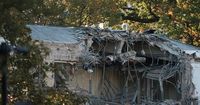On Monday, October 20, 2025, the White House’s East Wing became the site of dramatic change as demolition crews began tearing into its storied facade. The project, spearheaded by President Donald Trump, aims to construct a new $250 million (£186 million) ballroom—a move that has sparked both excitement and controversy across Washington and beyond.
According to Reuters, heavy machinery was seen picking apart the East Wing, a part of the White House complex that has long housed the first lady’s offices, a theater, and the visitor’s entrance that welcomes foreign dignitaries. The East Wing, originally built at the dawn of the 20th century and last modified in 1942 during Franklin D. Roosevelt’s administration, has stood witness to countless moments in American history. Now, it’s being reshaped in the image of a president known for his flair for the dramatic and his background in real estate development.
President Trump has been unambiguous about his ambitions for the new ballroom. Back in July 2025, he declared, “It will be beautiful. It won’t interfere with the current building. It won’t be—it will be near it, but not touching it. And pays total respect to the existing building, which I’m the biggest fan of. It’s my favorite.” As reported by Sky News, Trump also insisted that the ballroom project would be funded privately—by himself and donors—stating there would be “zero cost to the American taxpayer.” On his social media platform, Truth Social, he further emphasized, “The White House Ballroom is being privately funded by many generous Patriots, Great American Companies, and, yours truly.”
The new ballroom is envisioned as a space of grandeur. Trump has promised that future parties will commence with cocktails in the East Room before guests are ushered into what he touts as the “finest” ballroom in the country. The venue is set to offer sweeping views of the Washington Monument and accommodate up to 999 people, though some estimates place that number closer to 600. “Completely separate from the White House itself, the East Wing is being fully modernized as part of this process, and will be more beautiful than ever when it is complete!” Trump wrote on Truth Social.
The project broke ground even as it lacked formal approval from the federal agency responsible for overseeing such major changes to the White House complex. That hasn’t deterred Trump, who told visiting Louisiana State University baseball athletes in the East Room, “Right behind us, we’re building a ballroom. I didn’t know I’d be standing here right now ‘cause right on the other side you have a lot of construction going on, which you might hear periodically.”
For Trump, the ballroom is more than just an architectural addition—it’s a symbol of his presidency’s vision for the White House. “There’s never been a president that was good at ballrooms,” he quipped earlier this year. “I’m good at building things and we’re going to build quickly and on time. It’ll be beautiful, top, top of the line.” He’s also pointed out that presidents have “wanted a ballroom” in the White House for 150 years, suggesting that he’s fulfilling a long-standing desire of his predecessors.
The ballroom project is just the latest in a series of changes Trump has brought to 1600 Pennsylvania Avenue. As noted by Reuters and Sky News, he has hand-picked gold ornamentation for the Oval Office and redesigned the Rose Garden, infusing the executive residence with his signature style. Trump’s ambitions for Washington extend beyond the White House walls: he has also proposed an Arc de Triomphe-style monument to commemorate the United States’ 250th anniversary in 2026.
Yet the scale and symbolism of the new ballroom have not been universally embraced. Some see it as a fitting upgrade, addressing a practical need. The East Wing, after all, was built over a presidential bunker during World War II and sometimes strains to accommodate the ever-growing number of employees, guests, and visitors. Several state dinners have had to be hosted in tents on the South Lawn due to space constraints.
Still, critics argue that the project crosses a line. Former Republican Congressman Joe Walsh was particularly scathing, calling the plans an “utter desecration.” Walsh went so far as to declare that if he were to become president, he would take “a bulldozer” to the ballroom. His comments reflect a broader unease among some historians and political figures who worry about the impact such a massive addition could have on the integrity of one of America’s most iconic landmarks.
The White House itself declined to comment on the demolition when approached by Reuters on Monday. Meanwhile, images of the construction—showing the East Wing’s facade torn open and debris scattered across the grounds—have fueled debate about tradition, preservation, and presidential legacy.
Trump, ever the showman, has leaned into the controversy. He has repeatedly stressed that the new structure “pays total respect to the existing building,” emphasizing his admiration for the White House’s history and architecture. Supporters argue that the privately funded ballroom is a testament to Trump’s commitment to both grandeur and fiscal responsibility. Detractors, however, question whether such a lavish project is appropriate or necessary, especially given the building’s historical significance and the lack of federal oversight.
As construction continues, the nation watches with a mixture of curiosity, skepticism, and anticipation. The new ballroom promises to reshape not only the physical landscape of the White House but also the ongoing conversation about how history, tradition, and modernity intersect at the very center of American power.
One thing is clear: the East Wing’s transformation is more than just bricks and mortar. It’s a reflection of competing visions for the presidency, the country’s heritage, and the role of spectacle in American political life. Whether the ballroom will one day be remembered as a bold stroke of presidential vision or a controversial misstep remains to be seen. For now, the jackhammers keep pounding, and the White House enters yet another chapter in its long and storied history.
